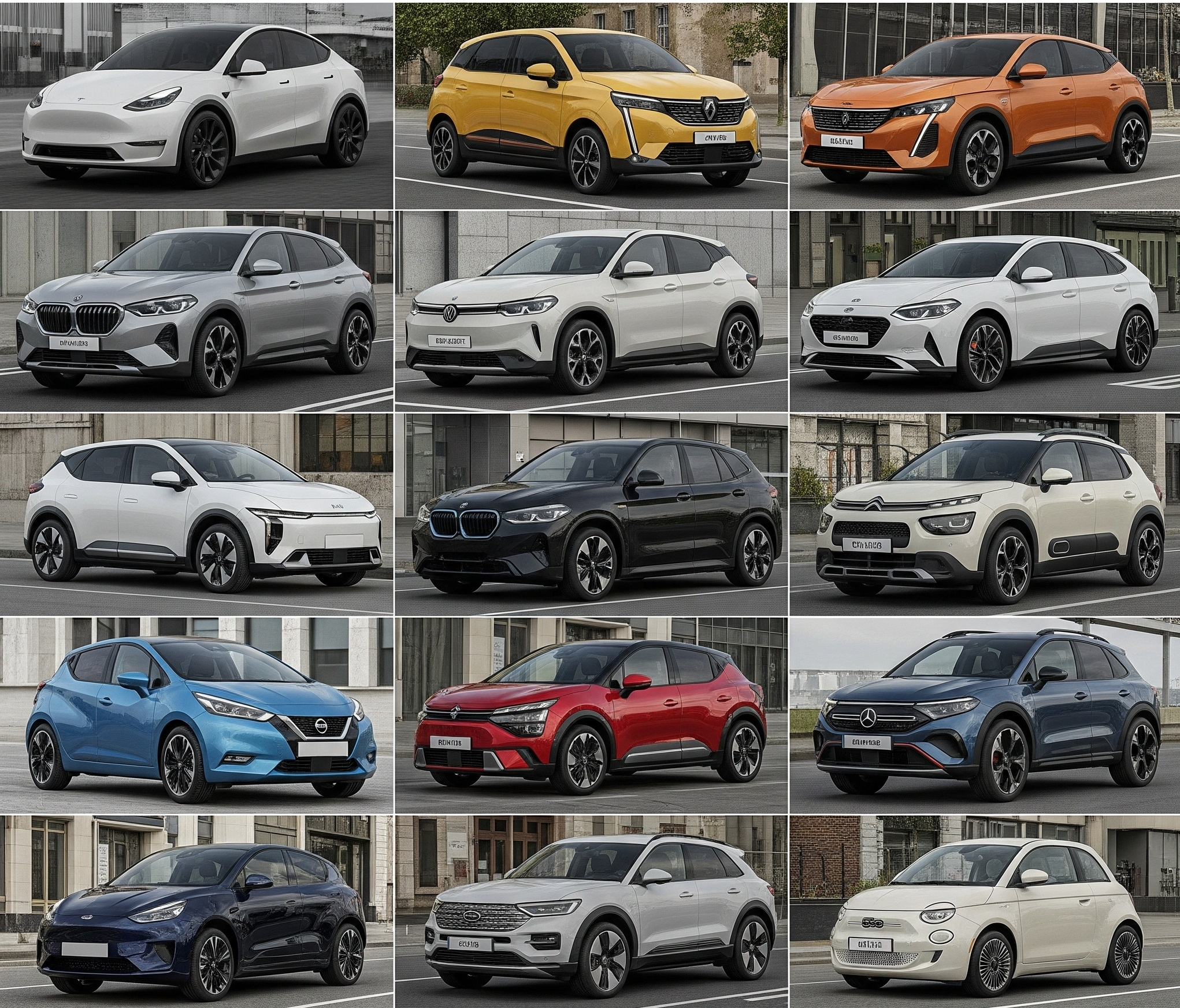Driving Through Time: Key Moments in Auto History
Summary
Explore the exciting story of how cars have changed over time. See the big inventions and cultural shifts that built the auto industry. From Nikolaus Otto’s first four-stroke engine and Karl Benz’s first car to Henry Ford’s Model T that made cars cheap for everyone, follow the path of car greatness. Learn how famous cars go beyond just working—they shape design, tech, and society. See how different times and places influenced car styles, from fancy pre-war cars to bold American designs versus simple European ones, fast sports cars, fuel-saving models from the 70s-90s, tiny space-savers, and the electric car boom started by GM’s EV1 and boosted by Tesla. Discover how car designs show the tech, money, and culture of each era.
What We Will Learn
Jump into the thrilling tale of cars changing from rough machines to smooth icons of progress. Find out the key events that built car history, from early shaky engines to modern electric wonders. Learn what makes a car legendary—not just pretty, but a mix of smart engineering and cultural buzz. See how times and places shaped car ideas, like bold American style versus neat European looks. And check out how tech, looks, and society work together to push the car world ahead, turning every ride into a story of human smarts.
A Concise History of the Automobile
The story of cars is one of the biggest changes in human technology. Big inventions have kept changing how we travel, live, and make things. The table below lists the most important moments and designs in car history over 160 years. From Nikolaus Otto’s four-stroke engine idea in 1862 to today’s electric cars led by Tesla and BYD, each step changed car tech and affected how we make, buy, and use cars worldwide. These milestones show the industry’s growth: from early engines, to making cars for everyone, to focusing on safety and comfort.
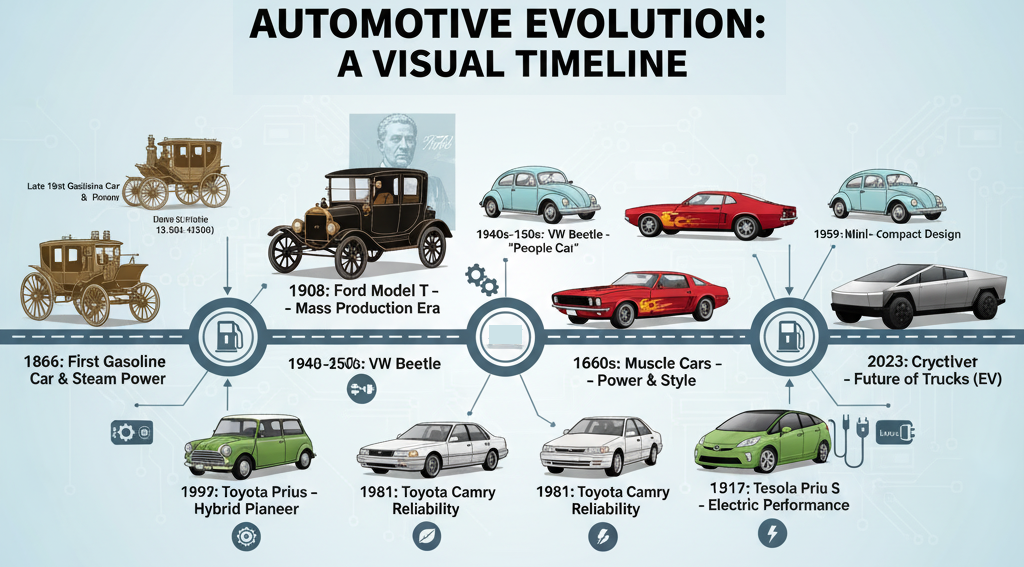
Iconic Vehicles and Moments in Automotive History
The following table summarizes key moments and designs in automotive history, highlighting their significance in shaping the industry.
| Year | Iconic Moment/Design | Significance |
|---|---|---|
| 1832 | First electric car by Robert Anderson | Foundation of automotive |
| 1876 | ICE 4-stroke developed by Nikolaus Otto | Foundation of modern gasoline engines |
| 1878 | Diesel engine developed by Rudolf Diesel | Foundation of modern diesel engines |
| 1886 | Benz Patent-Motorwagen (Karl Benz) | First gasoline-powered automobile |
| 1912 | Invention of starter motor by Delco USA | Ease of starting a car; began demise of electric cars |
| 1908 | Ford Model T (Henry Ford) | First mass-produced car; revolutionized assembly lines |
| 1913 | Cadillac introduces the electric starter | Eliminated hand-cranking, boosting ICE adoption |
| 1922 | Lancia Lambda (unibody construction) | Pioneered monocoque chassis design |
| 1934 | Chrysler Airflow (streamlined design) | Early aerodynamic influence on car design |
| 1939–1945 | The Second World War (WW2) | Paused civilian auto production; accelerated industrial tech |
| 1945–2003 | Volkswagen Beetle (designed in 1938) | Iconic people’s car; one of the best-selling models ever |
| 1948–1990 | Citroën 2CV (designed in 1937) | Toute Petite Voiture – utilitarian design |
| 1949 | Fiat 500 | Excellent packaging; Italian postwar icon |
| 1956 | The Suez Crisis | Fuel shortages impacted car design trends |
| 1959 | Mini (Alec Issigonis) | Transverse FWD layout maximized interior space |
| 1964 | Ford Mustang (Pony Car debut) | Created the “muscle car” segment |
| 1966 | Toyota Corolla (start of global dominance) | Reliability and affordability made it a best-seller |
| 1973 | Oil Crisis | Sparked global demand for fuel-efficient cars |
| 1974 | Volkswagen Golf (Mk1) | Replaced the Beetle; pioneered modern FWD hatchbacks |
| 1977 | Honda Accord | First Japanese car with U.S. production; set reliability standards |
| 1978 | Porsche 928 (First V8 Porsche) | Innovative grand tourer with controversial design |
| 1980 | Audi Quattro (First mass-produced AWD) | Revolutionized rallying and performance cars |
| 1981 | DeLorean DMC-12 | Stainless steel body; immortalized by Back to the Future |
| 1983 | Toyota Camry | Became America’s best-selling car by the 1990s |
| 1984 | Chrysler Minivans (Dodge Caravan/Plymouth Voyager) | Created the modern family minivan segment |
| 1989 | Mazda MX-5 Miata | Revived the affordable roadster market |
| 1990 | Honda NSX | First supercar with reliability; aluminum monocoque |
| 1997 | Toyota Prius (First mass-produced hybrid) | Paved the way for eco-friendly cars |
| 2003 | Tesla Motors founded | Accelerated the electric vehicle revolution |
| 2008 | BMW GINA (Fabric-skinned concept) | Pushed boundaries in material innovation |
| 2012 | Tesla Model S | Proved EVs could be desirable and high-performance |
| 2015 | Dieselgate Scandal (Volkswagen) | Crushed diesel car reputation; boosted EVs |
| 2020 | COVID-19 Pandemic | Disrupted supply chains; accelerated digital car sales |
| 2023 | Tesla Cybertruck | Polarizing but revolutionary stainless-steel EV truck |
Iconic designs
What Defines an Iconic Automotive Design?
In the car world, an iconic design is more than a pretty car—it’s a classic that sticks in our culture and memory. These cars stand out with unique shapes, like the Porsche 911’s sloped roof or the Jeep Wrangler’s tough, boxy look, easy to spot even years later. Beyond looks, they show new ideas, from smart engineering (like the Citroën DS’s advanced suspension) to bold styles (such as the Lamborghini Countach’s sharp wedge). They create strong feelings, through old memories, speed history, or pure want, keeping them fresh long after they stop being made.
A big part is timelessness—it doesn’t look old as styles change. Cars like the Jaguar E-Type or Ford Mustang were stunning at launch, with perfect shapes and details that still wow fans. Iconic designs also build a brand’s image, like symbols of what the maker stands for. The Rolls-Royce Phantom screams luxury, while the Mini Cooper means small, fun efficiency. These cars don’t chase trends—they set them, shaping future models while staying special.
Finally, a car design becomes iconic with cultural power, going beyond just transport. Some, like the Volkswagen Beetle or Ford Model T, changed society by letting everyone drive. Others, like the DeLorean or Aston Martin DB5, live on in movies. Racing stars, like the Ford GT40 or Audi Quattro, won on the track. Through history, media, or genius engineering, these cars become era symbols, loved by fans everywhere. True icons are ones people still admire, talk about, and dream of owning—proof that great design lasts.
Next, we look at key moments and designs in car history to see what made them iconic.
First Engine in History (1876)
Nikolaus August Otto, a German inventor, changed transport and machines with the first useful four-stroke engine in 1876. It worked on the Otto cycle: four steps—intake, compression, power, exhaust. This made fuel burn better than old two-stroke engines, saving gas and cutting pollution. Otto’s idea built the base for today’s car engines, still the main type. It ran on gas and made 2-3 horsepower, a key step toward making cars for everyone and changing society.
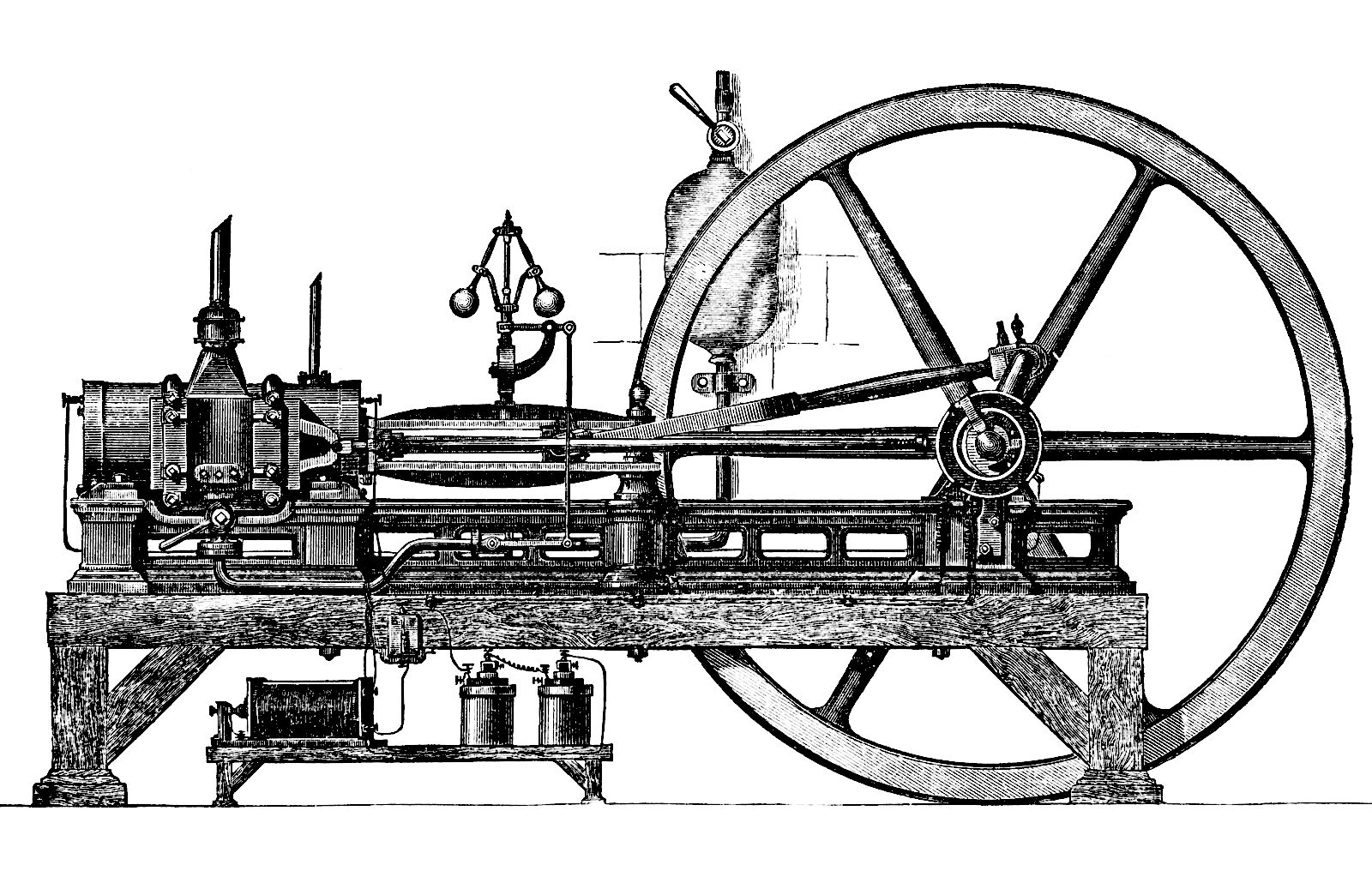
Three-horsepower internal-combustion engine fueled by coal gas and air, illustration, 1896.
First car in History (Benz Patent-Motorwagen 1886)
The Benz Patent-Motorwagen, made in 1886 by Karl Benz, is seen as the world’s first gas-powered car. It had a single-cylinder four-stroke engine, rear-wheel drive, and a steel frame. It topped 16 km/h (10 mph), with three wire wheels and a tiller for steering. Benz’s wife, Bertha, proved it worked with a long trip in 1888. It started Mercedes-Benz and changed personal travel.
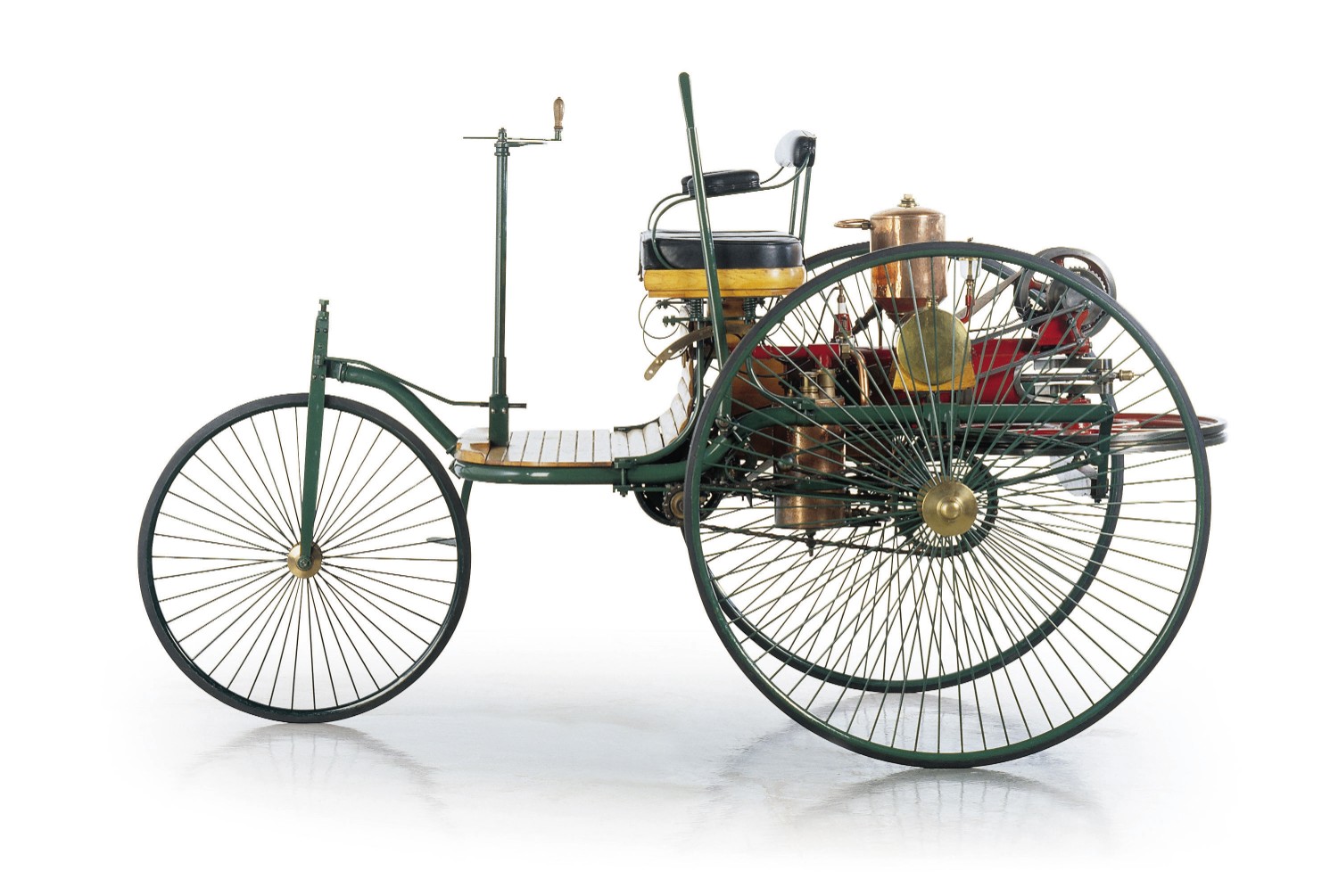
First mass produced car (Ford Model T 1908)
The Ford Model T, launched in 1908, changed the car industry as the first mass-made, cheap car. Made by Henry Ford, it had a 20-horsepower four-cylinder engine, planetary gears, and a light, strong frame of vanadium steel. Ford’s assembly line (1913) cut costs, letting middle-class people buy cars. Over 15 million sold before it ended in 1927. Its simple, reliable design and effect on travel made it one of history’s top cars.
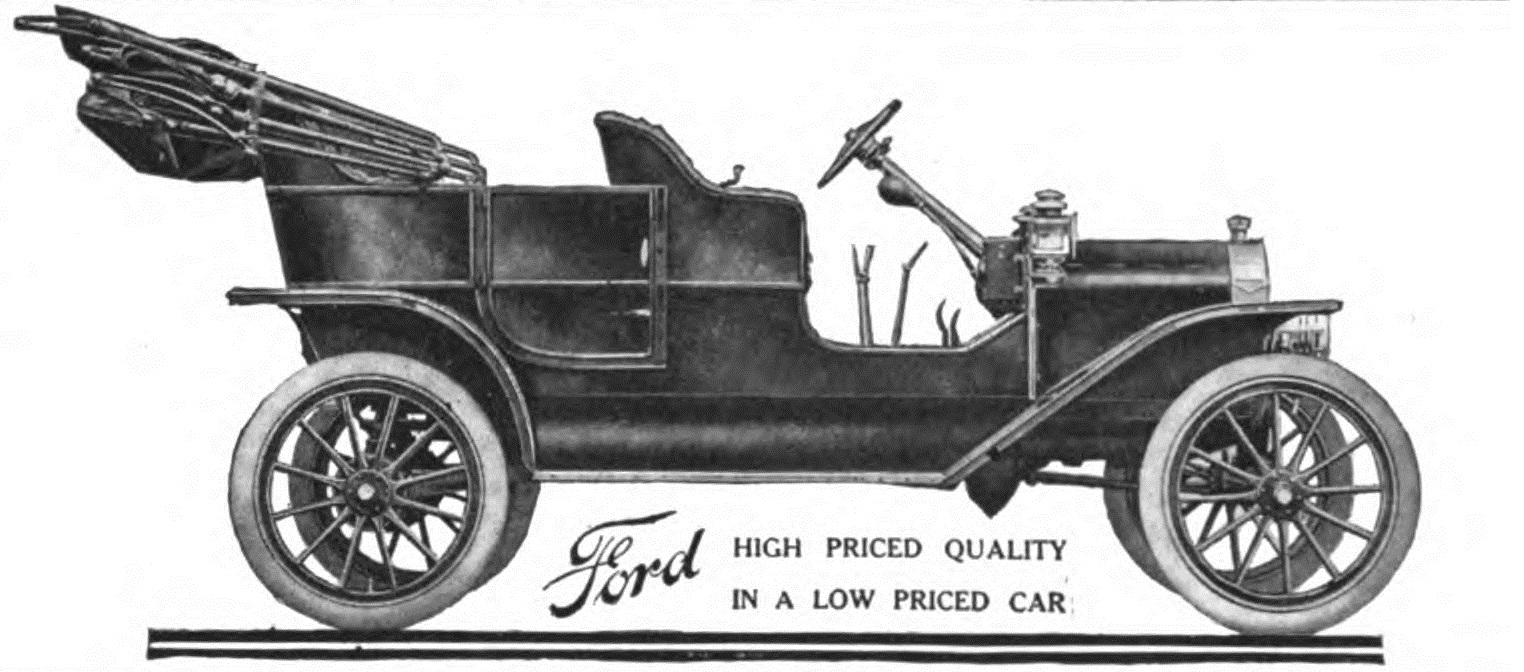
First Monocoque Structure (Lancia Lambda 1922)
The Lancia Lambda was a game-changer in car history, bringing new engineering that reshaped design. Made in the 1920s, it was the first car with a self-supporting body, ditching the old frame and body setup. This started unibody or monocoque building. It made the car light with a low center of gravity, boosting handling and speed over old designs. It had a narrow V4 engine with one camshaft for all valves, driven by gears. Suspension was advanced: independent front with hydraulic shocks and coil springs—a first for many. The rear used a solid axle with leaf springs. Built from 1922-1931, 13,000 made in 9 versions. Engine grew from 2.1L (49hp) to 2.6L (69hp), top speeds 70-75 mph. It was the first modern car with unibody, no separate frame, and independent front suspension. Its ideas still guide car building today. The photo shows the real 1922 Lambda with panels off, revealing the metal frame that makes it strong without a ladder frame.
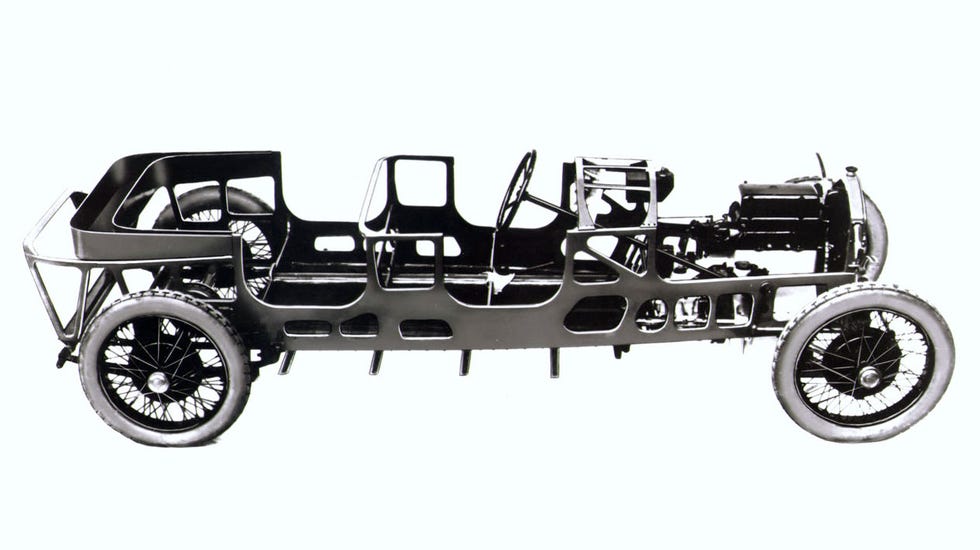
First Aerodynamic Car (Chrysler Airflow 1934)
The Chrysler Airflow, built 1934-1937, was a bold American car that brought streamlining to cut air drag and boost speed. Tested in wind tunnels—with help from Orville Wright—it had a smooth body and unibody build for strength and lightness. But its odd look and buyers’ dislike for new styles made it flop. Still, it marked a key step in car aerodynamics and design.
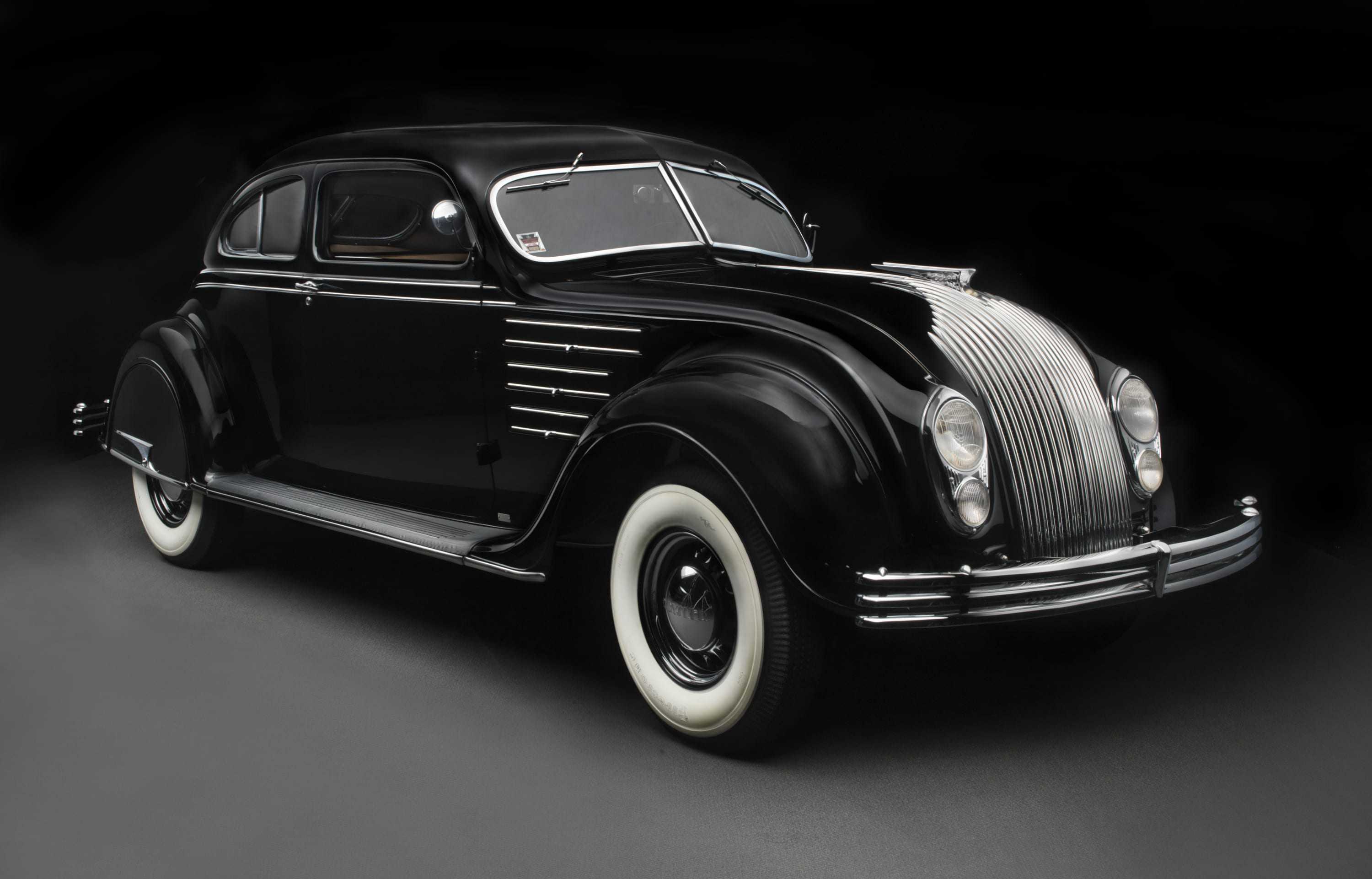
Luxury Vehicles (pre-WWII)
Before WWII, luxury cars stood out for top craftsmanship, smart engineering, and rarity. Often hand-made or in small batches for rich buyers who wanted status and ease. Top makers: Rolls-Royce, Packard, Duesenberg, Mercedes-Benz, Cadillac.
France led with strong luxury brands like Delage, Delahaye, Bugatti—elegant, fast cars with new styles, suspensions, and fancy insides.
In the US, Packard, Pierce-Arrow, Peerless (the “Three Ps”) meant prestige and tech. Packard added the modern wheel and early 12-cylinder engine.
These cars were more than rides—they showed wealth and progress, testing ideas that later went mainstream.
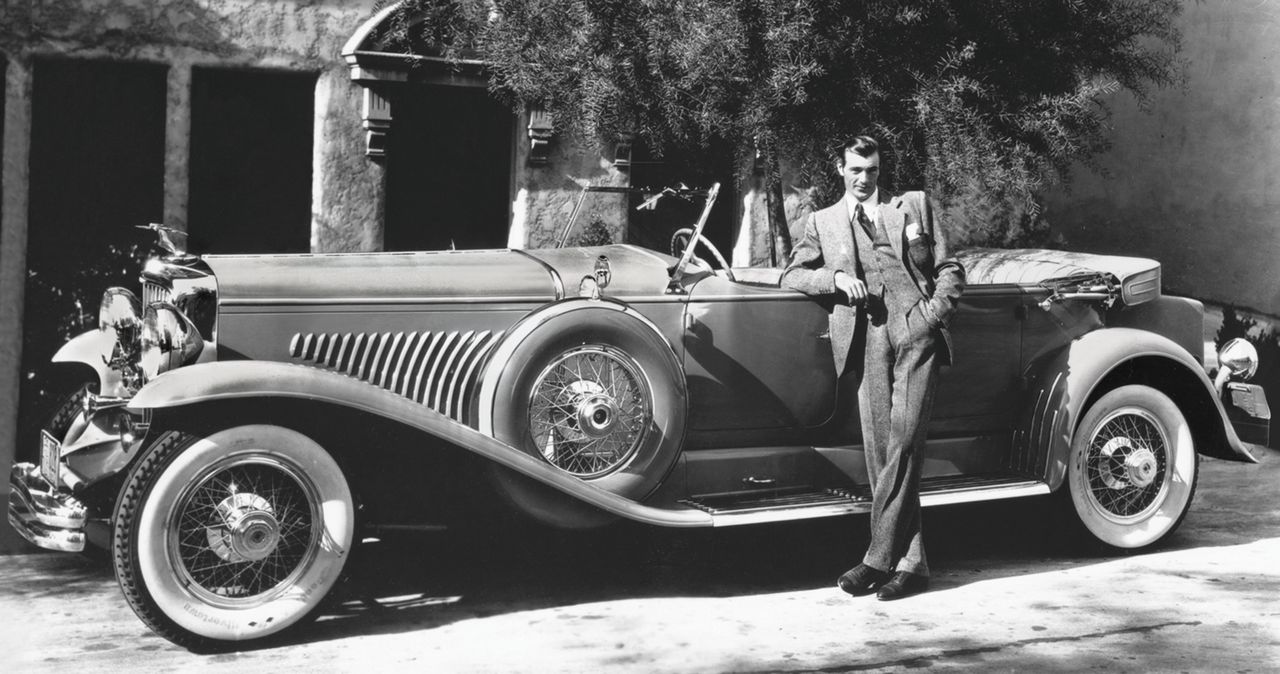

Utilitarian European Designs (post WW2)
- Citroën 2CV
The Citroën 2CV (“two horsepower”) was a game-changing cheap French car from 1948-1990. Made by Pierre Boulanger, first idea in 1937, to help rural France move from horses. Shown at 1948 Paris show, it became famous for simple design, low price, and usefulness.
It had an air-cooled front engine, front drive, and special suspension for rough roads—could carry eggs over a field unbroken. Light body, fold-back roof. First to use Michelin’s radial tires.
Over 42 years, 3.8 million made, plus 1.2 million vans/pickups. Its easy style and smart build made it a culture icon of post-war Europe.

- Volkswagen Beetle
The Volkswagen Beetle (Type 1) ran from 1938-2003, one of the most famous cars ever. Started as a “people’s car” in Nazi Germany, designed by Ferdinand Porsche. Its round shape and rear engine stayed the same for 65 years, with 21.5 million built. It stands for simple, cheap, timeless design.

- Fiat 500 (1957–1975)
The Fiat 500 (Cinquecento) was a small city car from 1957-1975. Made by Dante Giacosa for cheap urban driving, with rear air-cooled engine and light build. Though tiny, it became a culture icon for efficiency and charm. Lives on in new versions like the 2007 Fiat 500 with retro-modern mix.
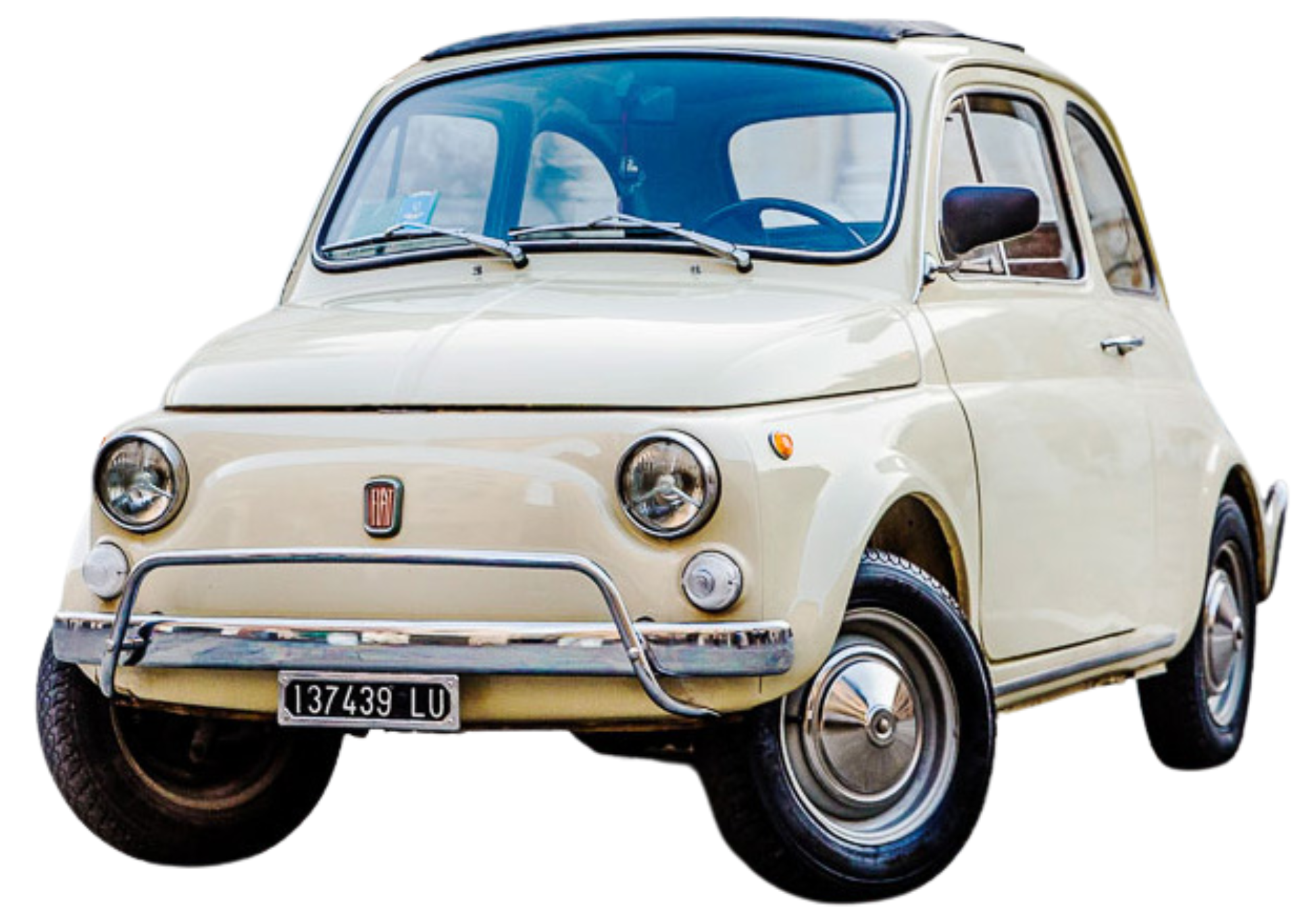
- The Mini (1959)
The Mini, made by BMC and later, from 1959-2000, was a bold British car. Designed by Alec Issigonis, it had a cross engine and front drive for max space—80% for people/luggage.
First sold as Austin Seven and Morris Mini-Minor, became Mini in 1969. Over 5.38 million made, one of Britain’s top sellers.
Came in saloon, estate, convertible, van—small, quick, cheap. Hit in racing, won Monte Carlo Rally many times in 1960s.
In 2000, ended; BMW bought and made new MINI. Original now Classic Mini, loved for culture and smart design.
.jpg)
American Designs (post WW2)
From WWII end to 1973 oil crisis, US car makers had a boom of wealth, tech, and culture. Bigger, stronger cars with bold looks like big fins, chrome, bold fronts. High-power V8s fueled muscle cars. Comfort grew with auto gears, AC, power aids. Cars became status symbols of freedom, in songs, movies, ads. But 1973 oil shock hit hard on gas-guzzlers, pushing buyers to efficient, green cars.
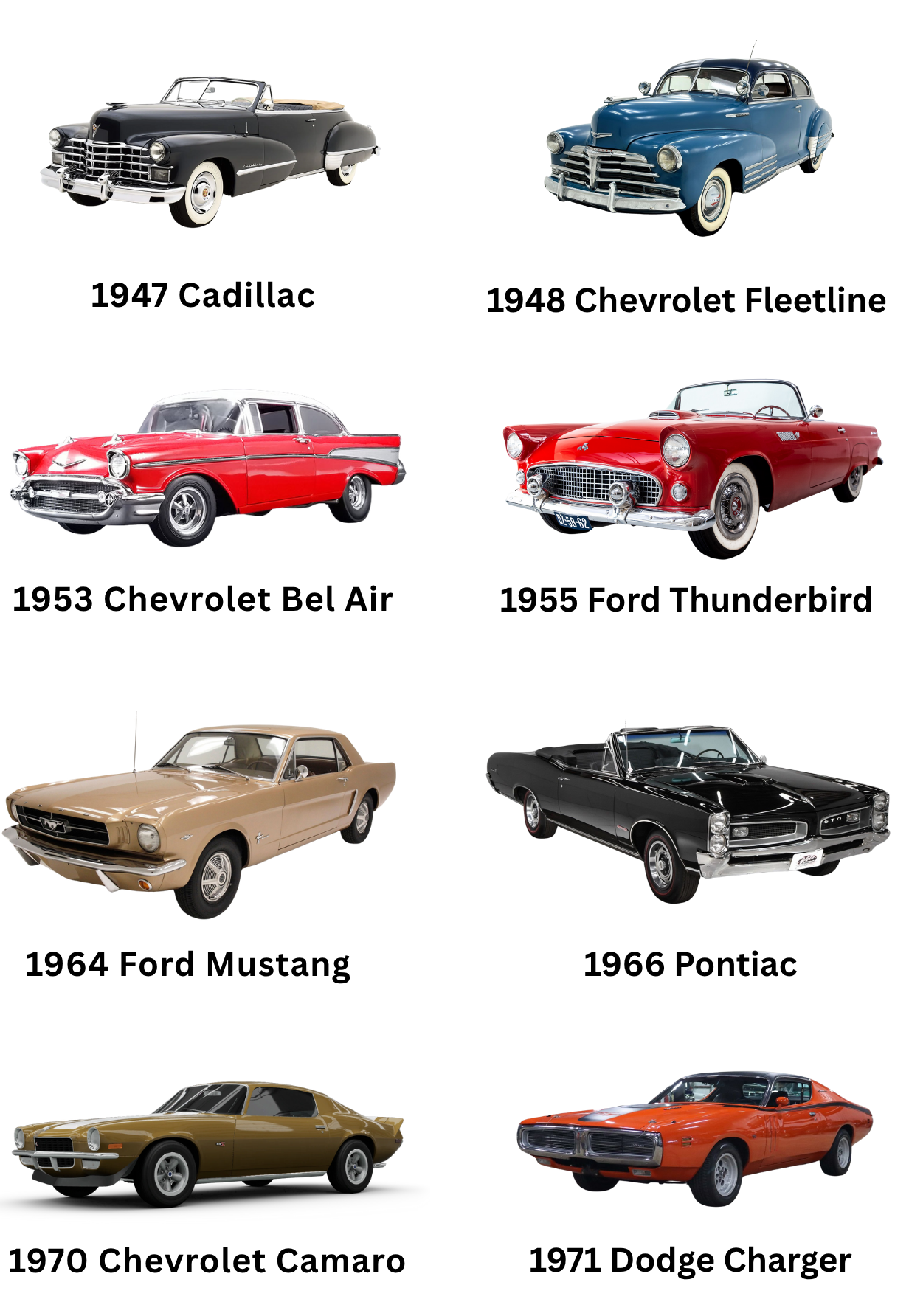
Sports Cars
- Porsche 911 (1964–Present)
Rear-engine, timeless shape. Keeps changing but stays a top sports car icon.
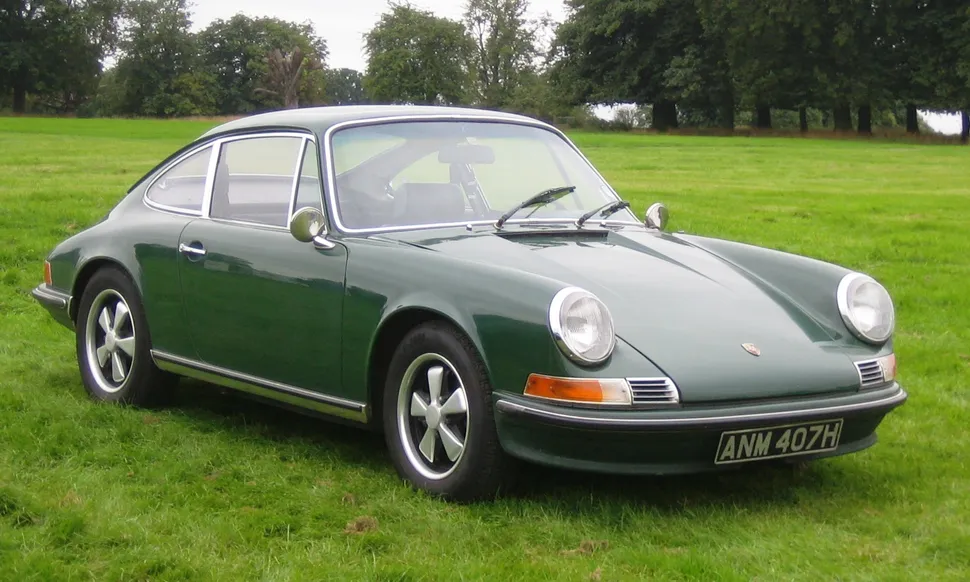
- Jaguar XJS (1975)
Bold follow-up to E-Type with flying buttress pillars, became a loved grand tourer.

- McLaren F1 (1992)
Top supercar with carbon frame, center seat, BMW V12—set speed marks, changed performance.
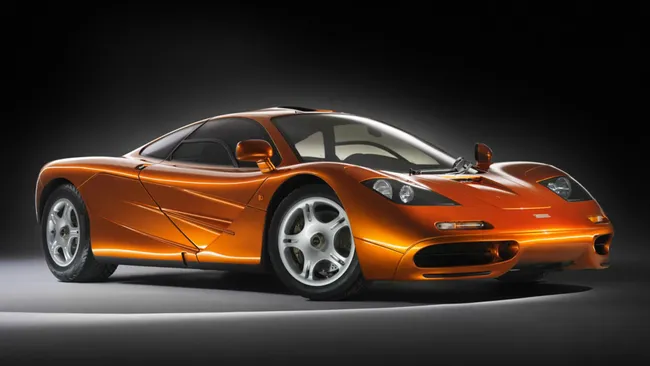
Reliable & Efficient Cars (1970s–1990s)
- Toyota Corolla (1966–Present)
Toyota’s Corolla is a top-selling compact car since 1966. Best-seller worldwide by 1974, beat Beetle in 1997. Redesigned often, from rear to front drive, some AWD. Made in Japan, Brazil, Canada, China, etc. Name from crown terms.

- Mercedes-Benz W123 (1975–1986)
Mercedes W123, 1975-1986, top durable executive car. Strong build, reliable, long-lasting—taxi favorite worldwide. 2.7 million sold, beat W114. Sedan, coupe, wagon, limo. Still praised for tough mileage.
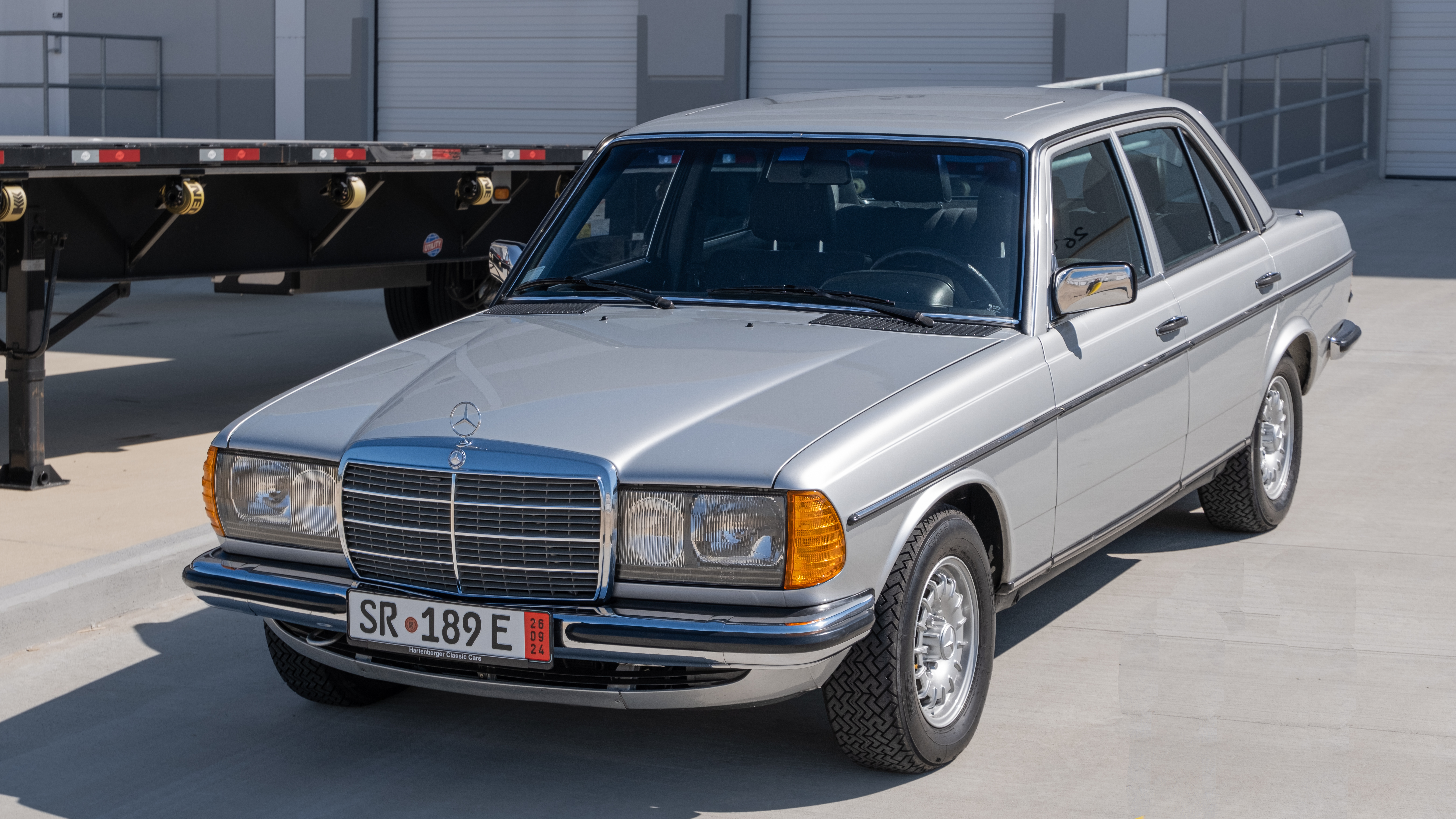
Micro Cars (1950s-present)
Microcars and Kei cars are small, efficient, cheap vehicles for cities. From post-war Europe and Japan. Microcars like BMW Isetta, Fiat 500 for short trips, simple insides, under 600cc engines, light build. Cheap, easy park. Kei cars from Japan (1949 rules): up to 660cc, tax/insurance perks. Models: Honda N360, Subaru 360, Suzuki Alto. Max space in small size. Evolved to sporty like Honda Beat, Daihatsu Copen. Niche for economy, green transport, second cars in busy areas. Help make mobility open, cut pollution, spark tight-space ideas.

| Model | Type | Length (mm) | Engine (cc) |
|---|---|---|---|
| BMW Isetta | Microcar | 2285 | 250–300 |
| Fiat 500 | Microcar | 2970 | 479–594 |
| Peel P50 | Microcar | 1370 | 49 |
| Honda N360 | Kei Car | 2995 | 354 |
| Subaru 360 | Kei Car | 2995 | 356 |
| Suzuki Alto | Kei Car | 3195 | 550–660 |
| Honda Beat | Kei Sports | 3295 | 656 |
| Daihatsu Cope | Kei Sports | 3395 | 658 |
Electric Cars (1996-present)
- General Motors EV1 (1996)
GM’s EV1, leased 1996-1999, first modern mass EV from a big maker for California’s zero-emission rules. Had regen braking, aluminum frame for lightness. Stopped in 2002 due to costs, demand; crushed most, shown in “Who Killed the Electric Car?”—famous EV case.

- Tesla (2008–Present)
Tesla Roadster (2008) first highway-legal mass EV with lithium batteries, 245 miles range—way better than old EVs. 0-60 in 3.7-3.9s, showed EVs can be fast and fun. 2,450 sold till 2012. Changed EV views, led to Model S.
- Modern EVs
